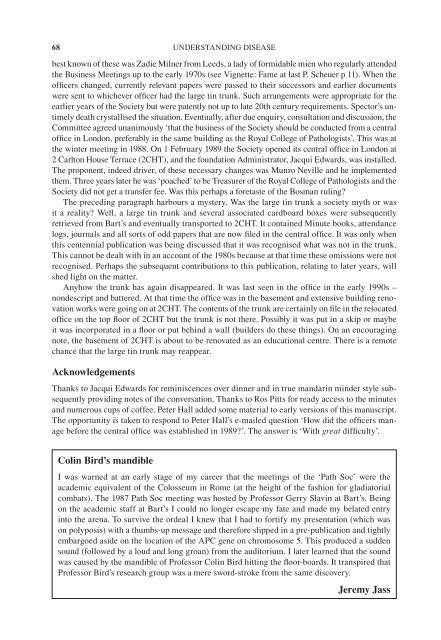chapter 5 - The Pathological Society of Great Britain & Ireland
chapter 5 - The Pathological Society of Great Britain & Ireland
chapter 5 - The Pathological Society of Great Britain & Ireland
You also want an ePaper? Increase the reach of your titles
YUMPU automatically turns print PDFs into web optimized ePapers that Google loves.
68 UNDERSTANDING DISEASE<br />
best known <strong>of</strong> these was Zadie Milner from Leeds, a lady <strong>of</strong> formidable mien who regularly attended<br />
the Business Meetings up to the early 1970s (see Vignette: Fame at last P. Scheuer p 11). When the<br />
<strong>of</strong>ficers changed, currently relevant papers were passed to their successors and earlier documents<br />
were sent to whichever <strong>of</strong>ficer had the large tin trunk. Such arrangements were appropriate for the<br />
earlier years <strong>of</strong> the <strong>Society</strong> but were patently not up to late 20th century requirements. Spector’s untimely<br />
death crystallised the situation. Eventually, after due enquiry, consultation and discussion, the<br />
Committee agreed unanimously ‘that the business <strong>of</strong> the <strong>Society</strong> should be conducted from a central<br />
<strong>of</strong>fice in London, preferably in the same building as the Royal College <strong>of</strong> Pathologists’. This was at<br />
the winter meeting in 1988. On 1 February 1989 the <strong>Society</strong> opened its central <strong>of</strong>fice in London at<br />
2 Carlton House Terrace (2CHT), and the foundation Administrator, Jacqui Edwards, was installed.<br />
<strong>The</strong> proponent, indeed driver, <strong>of</strong> these necessary changes was Munro Neville and he implemented<br />
them. Three years later he was ‘poached’ to be Treasurer <strong>of</strong> the Royal College <strong>of</strong> Pathologists and the<br />
<strong>Society</strong> did not get a transfer fee. Was this perhaps a foretaste <strong>of</strong> the Bosman ruling<br />
<strong>The</strong> preceding paragraph harbours a mystery. Was the large tin trunk a society myth or was<br />
it a reality Well, a large tin trunk and several associated cardboard boxes were subsequently<br />
retrieved from Bart’s and eventually transported to 2CHT. It contained Minute books, attendance<br />
logs, journals and all sorts <strong>of</strong> odd papers that are now filed in the central <strong>of</strong>fice. It was only when<br />
this centennial publication was being discussed that it was recognised what was not in the trunk.<br />
This cannot be dealt with in an account <strong>of</strong> the 1980s because at that time these omissions were not<br />
recognised. Perhaps the subsequent contributions to this publication, relating to later years, will<br />
shed light on the matter.<br />
Anyhow the trunk has again disappeared. It was last seen in the <strong>of</strong>fice in the early 1990s –<br />
nondescript and battered. At that time the <strong>of</strong>fice was in the basement and extensive building renovation<br />
works were going on at 2CHT. <strong>The</strong> contents <strong>of</strong> the trunk are certainly on file in the relocated<br />
<strong>of</strong>fice on the top floor <strong>of</strong> 2CHT but the trunk is not there. Possibly it was put in a skip or maybe<br />
it was incorporated in a floor or put behind a wall (builders do these things). On an encouraging<br />
note, the basement <strong>of</strong> 2CHT is about to be renovated as an educational centre. <strong>The</strong>re is a remote<br />
chance that the large tin trunk may reappear.<br />
Acknowledgements<br />
Thanks to Jacqui Edwards for reminiscences over dinner and in true mandarin minder style subsequently<br />
providing notes <strong>of</strong> the conversation. Thanks to Ros Pitts for ready access to the minutes<br />
and numerous cups <strong>of</strong> c<strong>of</strong>fee. Peter Hall added some material to early versions <strong>of</strong> this manuscript.<br />
<strong>The</strong> opportunity is taken to respond to Peter Hall’s e-mailed question ‘How did the <strong>of</strong>ficers manage<br />
before the central <strong>of</strong>fice was established in 1989’. <strong>The</strong> answer is ‘With great difficulty’.<br />
Colin Bird’s mandible<br />
I was warned at an early stage <strong>of</strong> my career that the meetings <strong>of</strong> the ‘Path Soc’ were the<br />
academic equivalent <strong>of</strong> the Colosseum in Rome (at the height <strong>of</strong> the fashion for gladiatorial<br />
combats). <strong>The</strong> 1987 Path Soc meeting was hosted by Pr<strong>of</strong>essor Gerry Slavin at Bart’s. Being<br />
on the academic staff at Bart’s I could no longer escape my fate and made my belated entry<br />
into the arena. To survive the ordeal I knew that I had to fortify my presentation (which was<br />
on polyposis) with a thumbs-up message and therefore slipped in a pre-publication and tightly<br />
embargoed aside on the location <strong>of</strong> the APC gene on chromosome 5. This produced a sudden<br />
sound (followed by a loud and long groan) from the auditorium. I later learned that the sound<br />
was caused by the mandible <strong>of</strong> Pr<strong>of</strong>essor Colin Bird hitting the floor-boards. It transpired that<br />
Pr<strong>of</strong>essor Bird’s research group was a mere sword-stroke from the same discovery.<br />
Jeremy Jass













